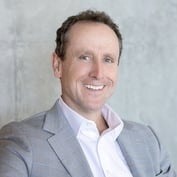In architecture, a keystone sits atop an arch bridging the two sides to lock in stable balance.
In biology, keystone species hold ecosystems together.
In financial advisory, the Keystone Conversation between advisor and client can be a sturdy framework to work together for a better, longer-lasting relationship, says Michael Bungay Stanier, founder of the training and coaching firm, Box of Crayons.
Just as critical, he says, the Keystone Conversation differentiates you from other advisors. “And that’s everything.”
The bestselling author’s new book is “How to Work With (Almost) Anyone: Five Questions for Building the Best Possible Relationships” (Page Two, June 2023).
In the interview, Bungay Stanier explains why having the Keystone Conversation (a phrase he created and trademarked) before even starting to address investments gives financial advisors a better chance to form robust, enduring relationships with clients.
“This is about: What’s a good client, and what’s a bad client. If you identify your ideal client, you can attract them,” he says.
In our chat, he deconstructs his five Keystone questions, which are: What’s your best? What are your practices and preferences? What can you learn from successful past relationships? What can you learn from frustrating relationships? How will you fix it when things go wrong?
Bungay Stanier, a Rhodes Scholar, has sold more than 1 million copies of his book, “The Coaching Habit” (2016) and has subsequently published three more titles.
In 2002, he founded Box of Crayons, a firm that trains people in large global organizations to be “more coachlike.”
Its client roster includes Gucci, Microsoft, Nestle Canada, Salesforce, TD Bank and UNICEF.
In the interview, Bungay Stanier recommends the words to use to apologize to a client — it’s “an insult” to say, “I’m sorry you’re feeling that way” — and why “deep listening” aces “fake listening” every time.
One of his most recent launches is MBS.works, which encompasses his books, keynote speaking engagements and blog.
“2 Pages With MBS” is his literary-oriented podcast.
ThinkAdvisor recently interviewed Bungay Stanier, who was speaking by phone from Toronto, where his companies are based.
One of the more provocative exchanges is about how the discussion of relationships that have gone sour can strengthen trust immediately between client and advisor.
It’s “a way of connecting at a more human level beyond the transaction, beyond, ‘Here’s your projected wealth,’” he explains.
Highlights of the interview follow:
THINKADVISOR: Financial advisors are eager to dive right in to help new clients with their investments. But you suggest that they should pull back at first. Why?
MICHAEL BUNGAY STANIER: Rather than start with the work that needs to be done, first have a conversation about the nature of the relationship rather than jumping into the water right away.
This is so the clients won’t say later, “The returns are fine, but the experience of working with you is underwhelming. I’m going to somebody else.”
Why should advisors and clients have what you call a Keystone Conversation?
You’ll have a chance to keep the really good relationships strong for longer and make the ones that aren’t that great more bearable and workable.
The earlier you have this conversation about how you want to work together, the easier it is and the better the chance of having a long-term relationship that has everything you’re both looking for.
You’ll have the opportunity to make some of the clients in the middle better and longer lasting.
In the middle of what?
I think financial advisors could map their relationships on a bell curve: a few ideal clients on one end. At the other end, clients who are a grind: Though you’re earning some money from them, there are times when it doesn’t feel like it’s worth it. Most clients are somewhere in the middle.
Does the Keystone Conversation help advisors build their client base?
Yes. It differentiates you from all the other financial advisors that are pitching. They all sound about the same when it comes to the services they provide, and they make the same promises about outcomes.
Whereas, if you say, “Let me tell you what a great client relationship looks and sounds like to me, and you tell me what a good relationship with a financial advisor looks and sounds like to you,” you have the opportunity to differentiate yourself from other advisors.
And that’s everything.
What questions do you ask in a Keystone Conversation?
One is, “When you’ve worked with somebody like me before and it’s gone really well, what happened? What was that like for you? What did they do?”
Another is, “When you had a frustrating working relationship with an advisor or some other advice-giving professional and felt diminished or like a cog in a big machine, what was that like?
“What drove you nuts? What was frustrating for you? What made that an unsuccessful experience?”
What else should you ask?
“What would it take for me to be the best possible advisor for you?”
If you have this conversation, they’ve not only given you the clues to start well but all the [information] for you to keep doing that.
Any other important questions to ask?
“If something goes off the rails a little, while we’re working together, how would you like us to deal with that? How should we resolve it?”
There’s something really powerful in asking that of a prospective client.
You write that talking about “failed relationships strengthens trust immediately and makes it more likely that you both will be able to navigate the tougher moments when they inevitably come into this working relationship.” Why does that trigger trust?









 July 03, 2023 at 03:10 PM
July 03, 2023 at 03:10 PM










